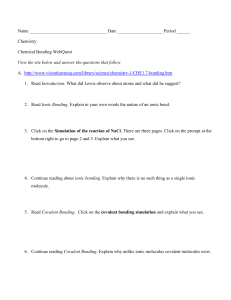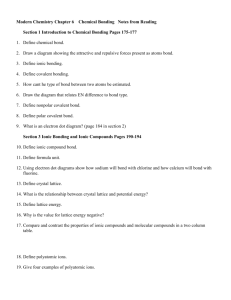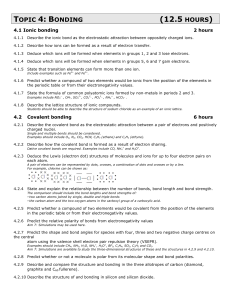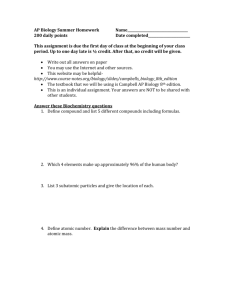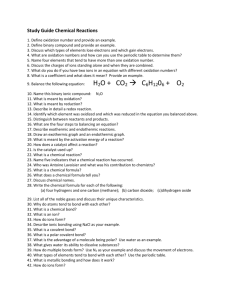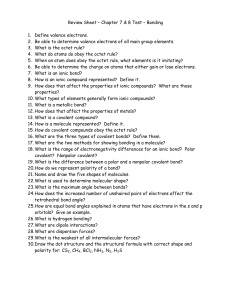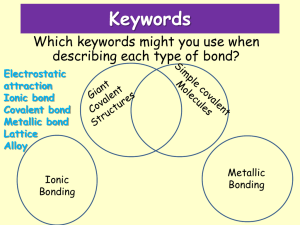Chemical Bonding and Intermolecular Forces Questions
advertisement
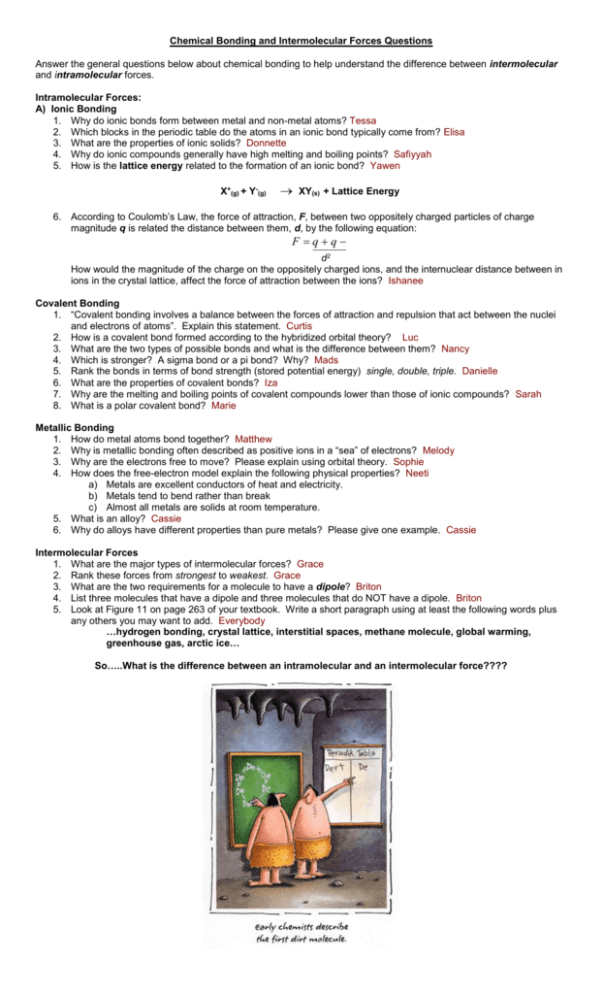
Chemical Bonding and Intermolecular Forces Questions Answer the general questions below about chemical bonding to help understand the difference between intermolecular and intramolecular forces. Intramolecular Forces: A) Ionic Bonding 1. Why do ionic bonds form between metal and non-metal atoms? Tessa 2. Which blocks in the periodic table do the atoms in an ionic bond typically come from? Elisa 3. What are the properties of ionic solids? Donnette 4. Why do ionic compounds generally have high melting and boiling points? Safiyyah 5. How is the lattice energy related to the formation of an ionic bond? Yawen X+(g) + Y-(g) XY(s) + Lattice Energy 6. According to Coulomb’s Law, the force of attraction, F, between two oppositely charged particles of charge magnitude q is related the distance between them, d, by the following equation: F qq d2 How would the magnitude of the charge on the oppositely charged ions, and the internuclear distance between in ions in the crystal lattice, affect the force of attraction between the ions? Ishanee Covalent Bonding 1. “Covalent bonding involves a balance between the forces of attraction and repulsion that act between the nuclei and electrons of atoms”. Explain this statement. Curtis 2. How is a covalent bond formed according to the hybridized orbital theory? Luc 3. What are the two types of possible bonds and what is the difference between them? Nancy 4. Which is stronger? A sigma bond or a pi bond? Why? Mads 5. Rank the bonds in terms of bond strength (stored potential energy) single, double, triple. Danielle 6. What are the properties of covalent bonds? Iza 7. Why are the melting and boiling points of covalent compounds lower than those of ionic compounds? Sarah 8. What is a polar covalent bond? Marie Metallic Bonding 1. How do metal atoms bond together? Matthew 2. Why is metallic bonding often described as positive ions in a “sea” of electrons? Melody 3. Why are the electrons free to move? Please explain using orbital theory. Sophie 4. How does the free-electron model explain the following physical properties? Neeti a) Metals are excellent conductors of heat and electricity. b) Metals tend to bend rather than break c) Almost all metals are solids at room temperature. 5. What is an alloy? Cassie 6. Why do alloys have different properties than pure metals? Please give one example. Cassie Intermolecular Forces 1. What are the major types of intermolecular forces? Grace 2. Rank these forces from strongest to weakest. Grace 3. What are the two requirements for a molecule to have a dipole? Briton 4. List three molecules that have a dipole and three molecules that do NOT have a dipole. Briton 5. Look at Figure 11 on page 263 of your textbook. Write a short paragraph using at least the following words plus any others you may want to add. Everybody …hydrogen bonding, crystal lattice, interstitial spaces, methane molecule, global warming, greenhouse gas, arctic ice… So…..What is the difference between an intramolecular and an intermolecular force????
